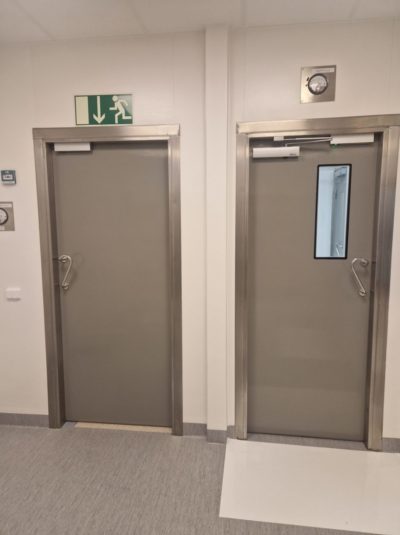Hermetic Doors Within Cleanrooms

The benefits of sliding hermetic doors within a cleanroom environment.
Within Cleanrooms, it is the function of the HVAC and overpressure to provide protection against the infiltration of contaminated air. A pressure differential should be maintained between adjacent zones or rooms, with the cleanest rooms operating at the highest pressure within the facility.
The amount of air introduced into a cleanroom is tightly controlled; so is the amount of air that is taken out. Generally, cleanroom pressurisation is achieved by taking out slightly less air than is put in. A minimum of 5pa overpressure between clean zones is required. The extra air then leaks out under the door or through the tiny crevices or gaps that are inevitably in any cleanroom. Pressure can be increased in a room by increasing the volume entering the room or reducing the leakage amount.
The cost of air control in a cleanroom can be comparatively high. The energy requirement of HVAC systems usually amounts to 50-75% of electricity consumption in a clean production space, due to the high airflow rates needed for particular ISO classes. However, when a door is opened, a significant exchange of air (with that of the outside air) will take place. This can affect the cleanliness of air within the room until such time that the HVAC can recirculate and clean the air again.
Entry should be through doors that are interlocked as an airlock in a cleanroom. This is to maintain cleanroom pressure differentials and to minimise human, process and product contact with contaminated air from particles, microbial agents or chemicals. Ideally, sealing rooms with differing pressures will increase cost efficiency, reduce air loss and keep the filter load low. Hermetic doors can play a huge part in the cost, efficiency and particle control of a cleanroom.
It is important that a door, particularly if automated, has an opening and closing speed that can be easily configured according to user requirements. All personnel doors should include self-closing mechanisms, which is also a legal requirement on fire doors.
Manual or automatic hermetic sliding doors may be useful when space is an issue, or to facilitate movement between spaces of similar cleanliness class for personnel whose hands are otherwise engaged. It is important that automated doors have on board safety sensors for both door, personnel and traffic safety protection. Touchless activation of the doors should also be considered.
Cleanrooms or operating theatres that have hermetic sliding doors can give consistent and fully predictable sealing and air leakage control over long periods. Hermetic sliding doors have a frame mounted seal that, along with special indentations in the track, uses the door’s own weight to seal perfectly against the frame and also the floor. Therefore, there is no need for a threshold, meaning ease of access for beds, trollies etc.







